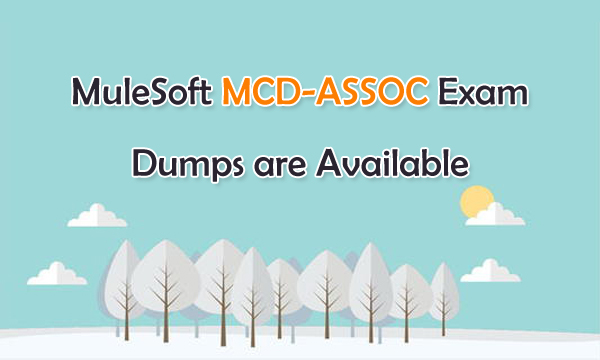MuleSoft MCD-ASSOC Exam Dumps are Available
July 31,2020 03:25 AM
Passing MCD-ASSOC exam is easy for MuleSoft candidates now. The MuleSoft Certified Developer–Integration and API Associate (Mule 3) MCD-ASSOC exam validates that a developer has the required knowledge and skills to design, build, test and debug, deploy, and manage basic APIs and integrations. To pass MCD-ASSOC exam in the first attempt, the official MCD-ASSOC exam information, topics and exam dumps are helpful in the preparation.

MuleSoft MCD-ASSOC Exam
The following MCD-ASSOC exam information can help you have a basic understanding of the test.
Format: Multiple-choice, closed book, proctored
Length: 60 questions
Duration: 120 minutes (2 hours)
Pass score: 70%
Language: English
Cost: $250
MCD-ASSOC Exam Topics
MuleSoft Certified Developer–Integration and API Associate (Mule 3) MCD-ASSOC exam topics cover the following details.
Explaining application network basics
Designing and consuming APIs
Accessing and modifying Mule messages
Structuring Mule applications
Building API implementation interfaces
Routing messages
Handling errors
Transforming data with DataWeave
Using Connectors
Processing records
Debugging and troubleshooting Mule applications
Deploying and managing APIs and integrations
Practice MuleSoft MCD-ASSOC Exam Dumps
We have cracked the latest MuleSoft certification MCD-ASSOC exam dumps, which can help you test the above topics. Share some MuleSoft Certified Developer–Integration and API Associate (Mule 3) MCD-ASSOC exam dumps questions and answers below.
1.What is the output type of the DataWeave map operator?
A. Map
B. Array
C. String
D. Object
Answer: B
2.What HTTP method should be used to add a new member to a collection in a RESTful service?
A. DELETE
B. PUT
C. POST
D. GET
Answer: C
3.According to MuleSoft’s point of view, what is the core activity that enables an application network to emerge in an organization?
A. Build point-to-point integrations that are referenced in a document library
B. Build applications that use the same communication protocols to connect to each other
C. Build modern APIs that are discoverable and reusable
D. Enforce and align all data mapping with a master data management system
Answer: C
4.What execution model is used by For Each and Batch scopes?
A. For Each is single-threaded and Batch is multi-threaded
B. Batch is single-threaded and For Each is multi-threaded
C. Both are multi-threaded
D. Both are single-threaded
Answer: A
5.What three layers are parts of Mulesoft’s definition of the API-led connectivity model?
A. System, Process, Experience
B. Model, View, Controller
C. Backend, Mediation, Frontend
D. Client, Proxy, Server
Answer: A
MCD-ASSOC Exam Dumps PDF & SOFT | 1 Year Free Update | Money Back Guarantee
- Related Suggestion
- MuleSoft Certified Developer - Level 2 Certification Info June 28,2023
- New Updated MuleSoft MCD-Level 1 Exam Questions December 25,2021
- MCIA-Level 1 MuleSoft Certified Integration Architect-Level 1 Updated Dumps May 19,2021
- MuleSoft MCD Level 1 Delta Exam Dumps December 12,2020
- MuleSoft Certified Platform Architect-Level 1 Dumps Questions February 01,2020

